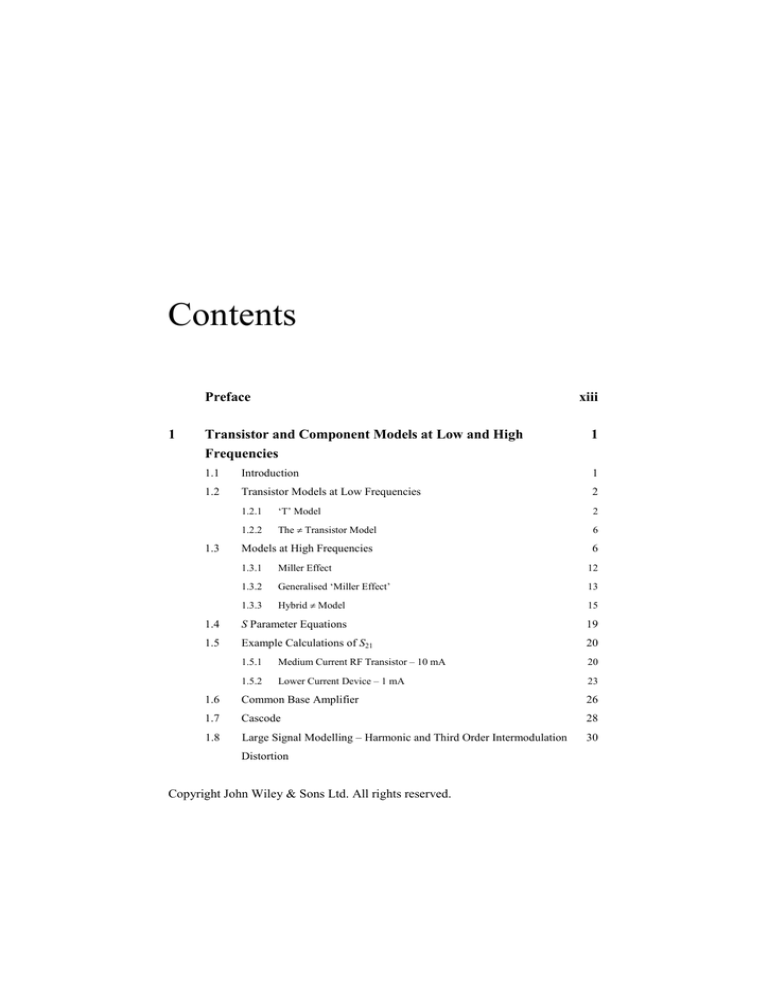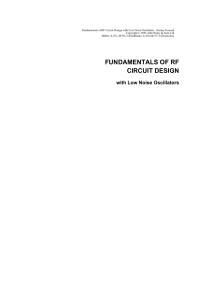
Contents
Preface
1
xiii
Transistor and Component Models at Low and High
Frequencies
1
1.1
Introduction
1
1.2
Transistor Models at Low Frequencies
2
1.2.1
‘T’ Model
2
1.2.2
The π Transistor Model
6
1.3
Models at High Frequencies
6
1.3.1
Miller Effect
12
1.3.2
Generalised ‘Miller Effect’
13
1.3.3
Hybrid π Model
15
1.4
S Parameter Equations
19
1.5
Example Calculations of S21
20
1.5.1
Medium Current RF Transistor – 10 mA
20
1.5.2
Lower Current Device – 1 mA
23
1.6
Common Base Amplifier
26
1.7
Cascode
28
1.8
Large Signal Modelling – Harmonic and Third Order Intermodulation
30
Distortion
Copyright John Wiley & Sons Ltd. All rights reserved.
viii
Contents
Common Emitter Distortion
30
1.8.2
Third Order Intermodulation Products
32
1.8.3
Differential Amplifier
35
1.9
Distortion Reduction Using Negative Feedback
40
1.10
RF MOSFETs
42
1.10.1
Small Signal Analysis
43
1.10.2
Capacitive Terms
43
1.10.3
Transition Frequency fT
44
1.10.4
MOSFETs y Parameters
44
1.10.5
Dual Gate MOSFETs
45
1.11
Diode Detectors
48
1.11.1
52
Minimum Detectable Signal Level – Tangential Sensitivity
1.12
Varactor Diodes
52
1.13
Passive Components
53
1.13.1
Resistors
54
1.13.2
Capacitors
56
1.13.3
Inductors
58
1.14
2
1.8.1
References and Bibliography
62
Two Port Network Parameters
63
2.1
Introduction
63
2.2
Impedance Parameters
66
2.3
Admittance Parameters
68
2.4
Hybrid Parameters
70
2.5
Parameter Conversions
71
2.6
Travelling Wave and S Parameters
73
2.6.1
Revision of Transmission Lines
73
2.6.2
Transmission Lines (Circuit Approach)
76
2.6.3
Characteristic Impedance
79
2.6.4
Impedance Along a Line Not Terminated in Z0
80
Copyright John Wiley & Sons Ltd. All rights reserved.
Contents
2.7
3
ix
2.6.5
Non Ideal Lines
82
2.6.6
Standing Wave Ratio (SWR)
82
Scattering Parameters
82
2.7.1
Example Calculation Using S Parameters
87
2.7.2
Simpler Method for Calculating S Parameters
88
2.7.3
S Parameter Summary
91
2.8
Attenuators (Pads)
92
2.9
Questions
93
2.10
Bibliography
96
Small Signal Amplifier Design and Measurement
97
3.1
Introduction
97
3.2
Amplifier Design Using Admittance Parameters
98
3.2.1
Stability
99
3.2.2
Amplifier Gain
101
3.2.3
Unilateral Assumption
103
3.3
Tapped LC Matching Circuits
104
3.3.1
109
Tapped C Design Example
3.4
Selectivity and Insertion Loss of the Matching Network
111
3.5
Dual Gate MOSFET Amplifiers
115
3.6
Noise
117
3.7
3.6.1
Noise Temperature
125
3.6.2
Noise Measurement System
126
Amplifier Design Using S Parameters and the Smith Chart
130
3.7.1
Smith Chart
130
3.7.2
Input and Output Impedance
134
3.7.3
Stability
135
3.7.4
Gain
139
3.7.5
Simultaneous Conjugate Match
141
3.7.6
Narrow Band Matching Using the Smith Chart for
143
Copyright John Wiley & Sons Ltd. All rights reserved.
x
Contents
Unilateral Amplifier Design
3.8
3.9
3.10
3.14
4
3.7.7
LC Matching Networks
144
3.7.8
Transmission Line Matching Networks
146
3.7.9
Smith Chart Design Examples
146
3.7.10
Amplifier Problems
155
Broadband Feedback Amplifiers
156
3.8.1
163
Broadband Design Examples
DC Biasing
166
3.9.1
Bipolar Transistors
166
3.9.2
GaAs MESFET Biasing
170
Measurements and Error Correction
171
3.10.1
Network Analyser
171
3.10.2
Test Jig
172
3.10.3
Calibration and Error Correction
173
3.10.4
One Port Error Correction
174
References and Bibliography
Low Noise Oscillators
177
179
4.1
Introduction
179
4.2
Oscillator Noise Theories
180
4.3
Equivalent Circuit Model
181
4.4
The Effect of the Load
191
4.5
Optimisation for Minimum Phase Noise
191
4.5.1
191
Models Using Feedback Power Dissipated in the Source,
Resonator Loss and Input Resistance
4.5.2
Models Using Power at the Input as the Limited Power
192
4.5.3
Models Using Power Available at the Output as the Limited Power
192
4.5.4
Effect of Source Impedance on Noise Factor
194
4.6
Noise Equation Summary
195
4.7
Oscillator Designs
196
Copyright John Wiley & Sons Ltd. All rights reserved.
Contents
4.8
xi
4.7.1
Inductor Capacitor Oscillators
196
4.7.2
SAW Oscillators
197
4.7.3
Transmission Line Oscillators
198
4.7.4
1.49 GHz Transmission Line Oscillator
201
4.7.5
900 MHz and 1.6 GHz Oscillators Using Helical Resonators
202
4.7.6
Printed Resonators with Low Radiation Loss
203
Tuning
204
4.8.1
Narrow Band Tuning
204
4.8.2
Varactor Bias Noise
204
4.8.3
Tuning Using the Phase Shift Method
205
4.8.4
Degradation of Phase Noise with Open Loop Phase Error
205
4.8.5
Broadband Tuning
206
4.8.6
Tunable 3.5–6 GHz Resonator
207
4.8.7
X Band Tunable MMIC Resonator
208
4.9
Flicker Noise Transposition
209
4.10
Current Methods for Transposed Flicker Noise Reduction
211
4.10.1
RF Detection and LF Cancellation
211
4.10.2
Direct LF Reduction
213
4.10.3
Transposed Gain Oscillators
215
4.10.4
Transposed Flicker Noise Suppression Using Feedforward
218
Amplifiers in Oscillators
5
4.11
Non-linear CAD
222
4.12
Summary for Minimum Phase Noise
223
4.13
Detailed Design Example
224
4.14
Method for Measuring the Unloaded Q of Coils
2.30
4.15
References
231
Mixers
235
5.1
Introduction
235
5.2
Single Balanced Mixer (SBM)
237
5.3
Double Balanced Mixer (DBM)
239
Copyright John Wiley & Sons Ltd. All rights reserved.
xii
6
Contents
5.4
Double Balanced Transistor Mixer
240
5.5
Double Balanced Diode Mixer
241
5.6
Important Mixer Parameters
244
5.6.1
Single Sideband Conversion Loss or Gain
244
5.6.2
Isolation
244
5.6.3
Conversion Compression
244
5.6.4
Dynamic Range
245
5.6.5
Two Tone Third Order Intermodulation Distortion
245
5.6.6
Third Order Intercept Point
245
5.6.7
LO Drive Level
247
5.7
Questions
247
5.8
Bibliography
247
Power Amplifiers
6.1
Introduction
248
6.2
Load Pull Techniques
249
6.3
Design Examples
252
6.3.1
Introduction
252
6.3.2
Switching Amplifiers
252
6.3.3
Class E Amplifiers
253
6.3.4
Broadband Class E Amplifers
256
6.3.5
Measurements
261
6.3.6
Non-linear Modelling
262
6.3.7
CAD of Input Matching Networks
267
6.3.8
Simulations of the Broadband Amplifiers
268
6.3.9
Load Angle Network
270
6.4
7
248
References and Bibliography
‘Real Time’ Large Signal Modelling
7.1
Introduction
Copyright John Wiley & Sons Ltd. All rights reserved.
273
274
274
Contents
xiii
7.2
Simulator
275
7.3
Form 1 (firstform.frm)
280
7.4
Form 2 (secondform.frm)
285
7.5
Form 3 (thirdform.frm)
286
7.6
Module 1 (Module1.bas)
287
Index
Copyright John Wiley & Sons Ltd. All rights reserved.
288




